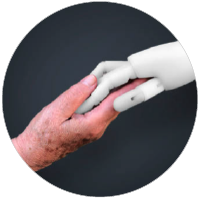By Caitlin Gibson December 28, 2021 at 10:21 a.m. EST Washington Post

She’d spent 15 grueling months as a single, working mom of two children in the coronavirus pandemic, so when Eliza McCoy stood in the bright sunlight at her older daughter’s elementary school graduation in June, she finally allowed herself a sense of hope. After months of remote schooling, followed by months of a hybrid schedule, the fifth-grade graduates were allowed to gather on the baseball field of their school in Alexandria, Va. The teachers gave speeches, the kids walked across the stage to collect their certificates, and it all felt almost normal, which in turn felt rather surreal.
“It was just momentous, to feel like things were getting better, like we were finally coming to the end of this thing,” McCoy says. She imagined that the world might look even more familiar and welcoming by the time her daughter, Gabriela, started sixth grade.
But when Gabriela joined her new middle school this fall, she found herself in a world of even stricter safety protocols, surrounded by peers who seemed to be struggling with the tension of the abrupt reentry. There were new rules about how to navigate the crowded hallways; arguments and physical fights between students were a daily occurrence.
“I remember her talking about it being jarring,” McCoy says. “There were lots of rules to learn, and when she told me there were physical altercations every day, I was just mind-blown.”
September once beckoned like a light on the horizon, with the promise of a full return to in-person school. But for countless families across the country, that hopeful glimmer proved to be more like a mirage, as school systems nationwide have grappled with myriad challenges this fall.
Eruptions of violence among students have led some schools to temporarily revert to virtual learning, hoping to quell the aggression. Exhausted teachers are quitting or considering early retirement. Mandatory quarantine periods and testing protocols mean that families are often faced with upended schedules. Kids who have been deprived of a stable learning environment and normal peer socialization for an extended period of time are finding the readjustment emotionally overwhelming — and they’re bringing their worries, questions and feelings about all of this home to their parents, who are faced with guiding their kids through yet another tumultuous transition.
Why So Many Teachers Are Thinking of Quitting
McCoy, who works for the National Center for Missing and Exploited Children, is acutely aware that many children suffered significant trauma during the pandemic. So when Gabriela came home feeling confused and unsettled by the fights she was witnessing, McCoy explained to her daughter that her peers might be processing a lot of complicated emotions and experiences.
“In the beginning she would come home and talk about specific incidents in detail — she was surprised particularly by one fight between girls, because she had never seen that sort of punching, hitting and kicking between girls,” she says. “But now she’s become a little conditioned to it, so if you ask her about it now, she’s like ‘Yeah, Mom, it happens all the time, and I just make sure I’m away from it.’ ”
Karen Petruska, an associate professor of communication studies at Gonzaga University in Spokane, Wash., says she’s grateful that her 3-year-old daughter, Margaret, and 6-year-old son, Henry, are young enough to be spared some of the psychological stress that older students are facing. But this school year has still been anxiety-producing for Petruska and her husband, who is also a professor, and their kids: “Margaret has had at least 10 covid tests,” Petruska says. “She’s at a new preschool, she’s exposed to a whole bunch of new kids, and so she gets sick — and every single time, you have to panic.”
No one in their household has had the coronavirus, Petruska says, yet they’ve spent plenty of time at home waiting for test results to come back, or for cold symptoms to resolve. “There was a day I missed a meeting because I had to drive 40 minutes to a different Walgreens to get more at-home tests,” she says. “But I support public health. It’s just the reality of living in a pandemic.”
McCoy shares that perspective — and as she and her parent friends have reconciled their hopes for this year against the reality they’re still facing, she says they’ve commiserated about how this transition sometimes feels like a new stage of grief. “We all wanted to go back to school so badly, and we felt like things were getting better,” she says. “But now it seems like it’s still so hard, just in different ways.”
The dreaded phone call came the weekend after Thanksgiving: A school official told Morgan Baden, a 42-year-old communications executive in Maplewood, N.J., that a child in her son’s preschool class had tested positive. “We get that call on a Sunday night, and suddenly our entire week has changed,” Baden says. “My husband and I have to sit down and figure out who changes what, which parts of our schedule can be adjusted and which can’t, who will cover which shift. It wasn’t our first quarantine, and I’m sure it won’t be our last.”
Baden’s 4-year-old son has autism, so quarantine means missing his daily therapies, she says, and it is especially challenging for him to be abruptly separated from his schedule. “We really depend on those routines to get him through the day. He needs to know what to expect,” she says. “Trying to get an autistic 4-year-old to embrace flexibility is a really big challenge.”
Gene Beresin, executive director for the Clay Center for Young Healthy Minds at Massachusetts General Hospital and professor of psychiatry at Harvard, says educators have told him that they’ve seen more “fidgetiness, oppositional behavior and defiance,” in their classrooms this year. “The kids who are more extroverted are more likely to be defiant,” he says. “The kids who are more internal, who are introverted, those are the ones who get more depressed and anxious and isolated.”
Adolescents and teens are more likely to be attuned to the stresses that weighed on America’s children even before the pandemic — worries about climate change, gun violence, economic inequality, racism — while younger kids might still be struggling with the abrupt separation from their parents after so much time together, Beresin says.
What the ‘return to normal’ means for toddlers who no longer remember ‘normal’
A disproportionate burden will fall, as it always does, on the most vulnerable children, including “underserved populations who have limited resources, who face environmental problems, who are dealing with unemployment, family stress, or poverty,” Beresin says, as well as children who were already coping with mental health or learning disorders.
It was February 2020 when a teacher suggested to Erin Neal, a 50-year-old aerospace lobbyist in Arlington, Va., that Neal’s now-8-year-old son, Ollie, should be tested for learning disabilities. But the testing was delayed by the pandemic, and it wasn’t until December 2020 that Ollie was diagnosed with dyslexia. “Now he’s finally getting a ton of services, which is fantastic, and he’s almost back up to grade level,” Neal says. “But he’s so exhausted. He’s getting pulled out of class half the day for interventions, and then he’s going after school to meet with a private tutor. … They’re doing so much to help him get caught up, and that’s great, but his little brain and heart and body are just physically fried by the time he gets home.”
The effects reverberate through the whole family, she says: “Any little ruffle or disturbance — a forgotten coat, a misunderstood joke, a cup of spilled milk, the loss of a board game, his sister selecting the wrong family movie — can set his emotions off course, causing a cascading effect to ruin his mood, and consequently the family’s entire day or evening.”
As a mother of four and a business manager at an elementary charter school in Annapolis, Md., Ratasha Harley has seen the emotional fallout of the pandemic from distinct vantage points. Just a couple of weeks ago, a young student told her that he’d been having suicidal ideations, and she took him immediately to meet with the school counselor. “There are emotional breakdowns, and I think kids are just not really knowing how to handle things that I think they would have handled seamlessly before,” she says. “The mental toll that all of this has taken on children, I don’t think we’ll ever really be able to measure that.”
As a parent, she is relieved that her own children, who range in age from 11 to 15, have shown such resilience throughout the transition. “I think what’s been so inspiring for me watching my children is that they were all so excited to go back to school,” Harley says. “Even my younger daughter, who is my introvert, who doesn’t have a lot of friends … but I could see how being isolated really affected her; it affected her grades, it affected her emotionally. And I thought that the biggest problem would be getting them up in the morning, getting them back into a routine, but the fact is that they were so excited just to be back in the school building.”
When McCoy’syounger daughter, Lena, started kindergarten during the pandemic, McCoy grieved the loss of a rite of passage — the proud moment when her little girl would walk into school for the first time. Instead, Lena was home with her mom for the entire school year, and when she returned to in-person school for first grade in September, she struggled with severe separation anxiety.Advertisement
“She just really devolved in that first month of school,” McCoy says. The school counselor told her that Lena’s response was not unusual, she says, “especially for kids going into first grade who missed that first-day-of-school transition into independent education the year before.”
Things have slowly been improving since then, and one recent afternoon as McCoy picked Lena up at school, the 7-year-old hopped into the car and declared: “Mom, I love my school!” McCoy was stunned. “I asked her, ‘Is it something specific that happened today?’ And she said, ‘No! It’s just great.’ ”
McCoy knew the epiphany might not last. There would surely be more quarantines, more safety protocols, more emotional fatigue in the new year. But in that moment, Lena was happy to be at school, and McCoy was so relieved that she started to cry.
Four months into this strange new school year, there is a mix of cautious optimism and weary resignation as parents look ahead. Vaccines for school-aged kids finally arrived, but so did the omicron variant. There is the feeling that we’re learning how to navigate all this, how to adapt to the altered landscape.
“I feel like there was a general sense that once the vaccines rolled out, we would be well on a path toward normalcy — and I think that narrative has changed a bit,” Baden says. “But I will say it feels a lot better than it felt this time last year, and I feel like I’m both a lot more optimistic and more realistic. I don’t think I foresee schools closing the way they did last year in the future.” She laughs nervously. “Hopefully.”
By Caitlin GibsonCaitlin Gibson is a feature writer at The Washington Post. Since joining The Post in 2005, she has contributed feature stories, essays, long-form enterprise and local news to the paper and The Washington Post Magazine. Twitter
















